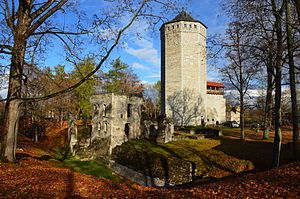
Back Paide piiramine (1602) Estonian Paidės apgultis Lithuanian Oblężenie Białego Kamienia Polish Осада Вейсенштейна Russian Belägringen av Weissenstein Swedish
This article includes a list of references, related reading, or external links, but its sources remain unclear because it lacks inline citations. (September 2014) |
| Siege of Weissenstein | |||||||
|---|---|---|---|---|---|---|---|
| Part of the Polish–Swedish War (1600–1611) | |||||||
 Paide (Weissenstein) castle ruins | |||||||
| |||||||
| Belligerents | |||||||
|
|
| ||||||
| Commanders and leaders | |||||||
| Unknown | |||||||
| Strength | |||||||
| 700 | 2,000 | ||||||
The siege of Weissenstein took place between 31 May and 30 September 1602, during the Polish–Swedish War of 1600–1611. Two weeks after the capture of Fellin, Grand Crown Hetman Jan Zamoyski led the Polish-Lithuanian army of 2,000 troops to besiege Weissenstein (now known as Paide in Estonia). Weissenstein, a major transportation hub in Estonia, was a site of strategic importance to both Poland and Sweden. Located among the marshes and built during the Teutonic period, the castle had strong artillery and was defended by 700 soldiers, local peasants, and townspeople. Weissenstein was a walled city with 30-meter towers at the corners and high bastions, and thus presented the attacking force with a significant barrier to success, even with siege works.